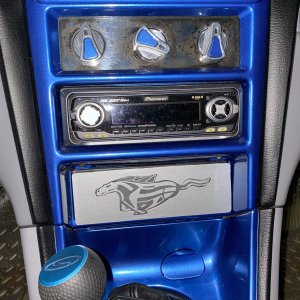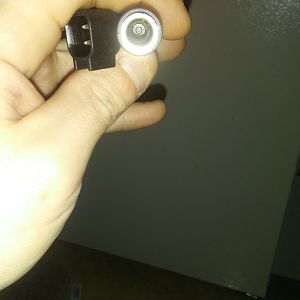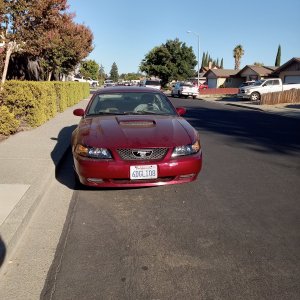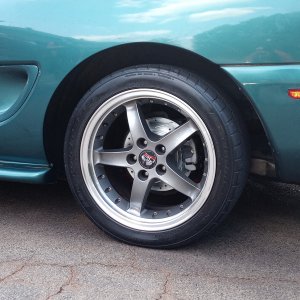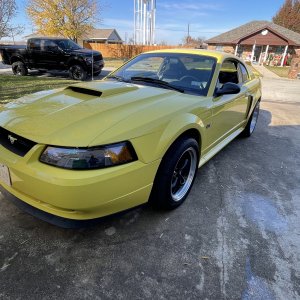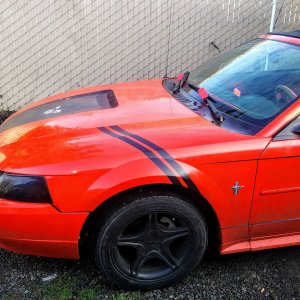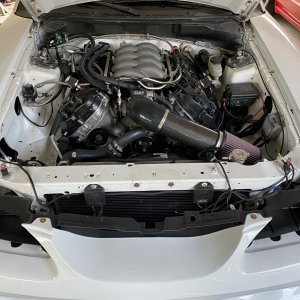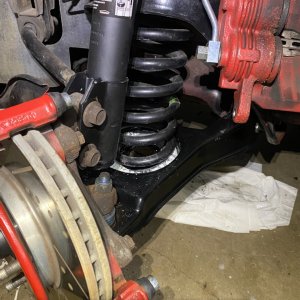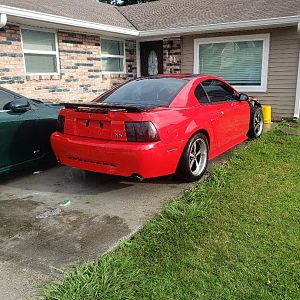Here is info on all the 4V's
B/Swirl Port: (93-97 Lincoln Mark VIII, pre 99 Lincoln Continental, 96-98 Cobra).
The first and only production Ford head with two (square primary, round secondary) intake ports per cylinder, these swirl port castings arrived first in the ’93 Lincoln Mark VIII. Aptly named, due to the way they promoted the incoming air to swirl into the combustion chambers, much like water running down the drain of a once full sink.
Through the years these heads have proven themselves to be excellent high rpm (8000rpm+) performersâ€â€mainly in power adder applications--since their tremendous combined intake port cross sectional area and volume (when combined, a full 55cc more than any other 4.6L head design) provide for exceptional power production in the upper regions of the tach. Ironically, it’s those same big, beautiful, twin ports that also prove to be the B head’s largest inherent design flaw. The extra intake port size has a tendency to kill low/mid rpm intake port velocity and power productionâ€â€hence the use of Ford’s first IMRC (intake manifold runner control) intake on the 96-98 Cobra. By allowing air to reach only one of a B head’s twin intake valves, velocity, and therefore low/mid range torque production was restored in situations under 3250rpm. Later head designs are clearly superior in this regard, which happens to be the one of the most important considerations for those wanting a stout street motor.
There is also some controversy over the single fuel injector/dual intake port setup. Some claim insufficient air/fuel mixing because of the compromised design, however, others contest that the ability to make 1000+rwhp with only minor porting and some form of power adder is testament to the contrary. Whoever you believe, there is little doubt that even after as little as 8,000 miles, carbon and other deposits tend to form on the secondary ports, causing a major airflow impedance, as there is no fuel present to clean them. B heads feature a somewhat small stock exhaust port that really hinders flow in power adder applications. Major gains from porting come with a quality valve job, some pocket and lots of exhaust work. There really isn’t a lot of material to remove from the intake ports themselves.
The Bottom Line: B heads aren’t the best choice for a naturally aspirated street motor. In order to really shine, they need to be paired with a power adder and a short block that can sustain high horsepower and rpm levels. These, the oldest heads, may still be a great choice for full race applications.
Stock Intake Choices: ‘93-‘97 Lincoln Mark VIII, ‘96-‘98 Cobra.
Aftermarket/Modified Stock Intake Choices: HCI, SSR, PHP.
B head dimensions: Combustion Chamber: 52cc, Intake Port Vol.: 107cc primary (square), 115cc secondary (round). Intake Port Entrance: 1.500x1.300†primary (square), 1.660x1.400†secondary (round), Valves: 37mm Int., 30mm Exh.
C/Tumble Port: (99/01 Cobra, 99 Lincoln Continental).
These second-generation Ford DOHC heads feature a single intake port per cylinder with a smaller cross sectional area that boosts incoming airflow velocity compared to previous years. To understand how C heads earn their “tumble port†designation, try to imagine an Olympic high diver doing repetitive front somersaults before cleanly entering a pool at the bottom. This controlled tumble allows for better air/fuel mixing than in the earlier swirl port heads. The new port design allowed for both substantial increases in midrange torque, and superior horsepower production under 8000rpm when compared with earlier heads. Combustion chamber size is also up 2cc.
The design downfall of C heads, and their larger (5.4L Navigator) cousins, is the relatively flat floor and utter lack of a short turn radius in the throat of the intake port. As such, the incoming air tends to overshoot the valves, making the port think the valves are smaller than they actually are. Some ‘99/’01 Cobra owners reported a “ticking/pinging†noise coming from the drivers side head of their cars. This is due to insufficient cooling around the #6, 7, and 8 cylinders that allowed the valves to overheat and therefore seat improperly. Ford remedied the situation by issuing a TSB to remove and replace the affected heads with a version that featured altered coolant flow.
C heads feature a small exhaust port much like Ford’s earlier swirl port heads, but unlike in B heads, both the intake (throat region) and exhaust ports can see extensive porting work. However, removing too much material from the intake port (mouth region) of a tumble port head will kill velocity very quickly, so make sure your head porter knows what they are doing!
The Bottom Line: C heads remain a viable performance upgrade for those looking for more punch in their street driven 4.6L four valve, without having to pay new part prices for the ’03 DOHC or FR500 versions. The increased midrange torque production and greater overall area under the power curve (when compared to swirl port heads) will enhance the performance of a street/strip driven (8,000rpm and under) modular regardless of application.
Stock Intake Choices: ‘99/’01 Cobra, ‘03/’04 Mach 1 & Aviator, ’03 Marauder, FR500.
Aftermarket/Modified Stock Intake Choices: Al Papitto short runner/ported ‘99/’01 Cobra, Sullivan, Aviator, '03/'04 Mach 1
C head dimensions: Combustion Chamber: 54cc, Intake Port Vol.: 177cc, Intake Port Entrance: 1.960â€Âx1.350â€Â, Valves: 37mm Int., 30mm Exh.
Navigator: (98+ Lincoln Navigator)
These 5.4L DOHC heads feature essentially the same intake port design as C heads, however they have a much larger intake port volume than 4.6L castings. Despite the fact these heads feature a relatively small exhaust port, the extra intake port volume could be very beneficial in helping fill a motor of greater displacementâ€â€think 5.4L. Expect slightly better midrange torque, and sub 8000rpm horsepower production than even C heads, however the larger intake port size leaves a slim selection of intakes to choose from when utilized on a 4.6L block. Forced induction fans take note, Navigator exhaust ports feature a thicker exhaust divider (while keeping the same overall exhaust port size as B,C, and FR500 heads) that allows coolant to circulate through this vital area. Conversely however, the larger divider can also hurt flow by utilizing additional space in the port.
The real downside to Navigator heads, when used on a 4.6L based motor, is the severe limitation they impose on intake selection. The physically larger 5.4L heads don’t leave a lot of room (when installed on a 4.6L block) between them for an intake plenum to sitâ€â€though they do bolt right up. Remember that since Navigator intake ports are essentially clones of those of C heads (just on a larger scale), they too suffer from the same intake port flaws that plague the earlier tumble port design--no short turn or floor in the throat of the intake port.
The Bottom Line: The extra port volume the Navi’s possess could be very beneficial in filling a motor with greater than 281 cubic inches of displacement, or in high rpm N/A street/strip or boosted combinations. Fans of boost should remember the cooled exhaust port divider. Lack of intake availability is the real downfall of this otherwise wonderful casting.
Stock Intake Choices: None (4.6L), 98+ Navigator (5.4L)
Aftermarket/Modified Stock Intake Choices: Al Papitto short runner 99 Cobra (4.6L), sheet metal
Navigator head dimensions: Combustion Chamber: 53cc, Intake Port Vol.: 184cc, Intake Port Entrance: 2.290â€Âx1.400â€Â, Valves: 37mm Int., 30mm Exh.
’00 Cobra R: (’00 Cobra R and now Ford GT/GT500 with .020" raised intake ports, unique adjusters, and better casting quality throughout)
Cobra R heads are bar none the best Modular heads available today. However, their extremely scare supply makes them both ridiculously hard to find, and unbelievably expensive.
Initial performance results are understandably hard to obtain, however Al Papitto reports that with only 25hrs of port work into the his new ‘00R heads, they have already eclipsed the performance of his old Navigator heads with months of labor in them. These heads feature larger intake and exhaust ports, +1mm larger exhaust valves, and a dry exhaust port divider. Cobra R heads also require the use of a specific valvetrain not shared with any other modular application due mainly to their overall physically larger size. Al also claims R heads have too much port volume for a street/strip 4.6L application; only consider them with a larger 5.4L motor or a serious 4.6L race application paired with some form of power adder.
The Bottom Line: The best heads you can or can’t find for a Modular four valve motor.
You are as likely to come across a set of these Modular “Godfather†heads as you are to be Catherine Zeta Jones' next uterus masseuse. Though based on their performance abilities, you may want to start saving, just in case…
Stock Intake Choices: None (4.6L), ’00 Cobra R (5.4L)
Aftermarket/Modified Stock Intake Choices: Sheet metal
’00 Cobra R head dimensions: Combustion Chamber: N/A , Intake Port Vol.: N/A , Intake Port Entrance: 2.370â€Âx1.300â€Â, Valves: 37mm Int. 31mm Exh.
Stock Intake Choices: ‘00R
Aftermarket Intake Choices: Sheetmetal.
FR500: (FRPP)
The sole “aftermarket†offering of the bunch, these high flow heads feature a modified C head intake port combined with the smallest port volume of the groupâ€â€it seems Ford meant to design these heads for high performance naturally aspirated applications. With the same small standard exhaust port as most other DOHC heads you will still have to remove a decent amount of material from the exhaust ports. Port entrance shape/size remains identical to C heads so finding an intake isn’t hard. These heads are capable of producing power beyond 8000rpm, where earlier versions of the tumble port castings begin to lose their luster. FR500 heads are prone to the #6,7, and 8 cylinder cooling problems as well. Major intake port differences between these and earlier tumble port heads include a raised intake port roof, and a real short turn radius that better directs the incoming air into the combustion chamber; not over the valves like in earlier versions of tumble port heads. These heads also feature a dry divider in the exhaust port, which allows for greater flow, but also higher temperatures. Though improved, the heads can still use some TLC from a quality porter to smooth the roughly finished and newly implemented short turn radius, and the standard exhaust treatment.
The Bottom Line: Outstanding performance heads, with exceptional low and mid lift flow capability. The FR500s only real fault is that the newer ’03 DOHC heads provide near identical performance capability (much better on the exhaust side) paired with a cost differential that is approximately two-thirds less than the FRPP castings. Still a great choice for any application, the heads readily pair to a wide variety of stock and aftermarket intakes.
Stock Intake Choices: ‘99/’01 Cobra, ‘03/’04 Mach 1 & Aviator, ’03 Marauder, FR500.
Aftermarket/Modified Stock Intake Choices: Al Papitto short runner/ported ‘99/’01 Cobra, Sullivan, Aviator, '03/'04 Mach 1
FR500 head dimensions: Combustion Chamber: 53cc, Intake Port Vol.: 160cc, Intake Port Entrance: 1.960â€Âx1.350â€Â, Valves: 37mm Int., 30mm Exh.
‘03 DOHC head: (‘03+ Aviator, Marauder, Cobra, Mach 1, Australian Boss 260/290)
Featuring a nearly identical (though 17cc larger in volume due to the fact that they are also used on the much larger Australian Boss 260/290 5.4L DOHCs) intake port to the FR500 head, but combining it with a newly designed, larger and more rectangular exhaust port, these may be the best all around DOHC Ford heads ever manufactured. The improvements made to the intake port shape over previous years include a raised port roof and the introduction of a short radius turn in the throat of the intake port that helps assure the incoming air charge finds the combustion chamber. For those with a forced induction street/strip motor, these are without question the best heads available, and as with the FR500s, they should produce great power up to and beyond 8000rpm regardless of application. ’03 DOHC heads also feature higher quality head castings from the supplier, which is at least partially responsible for the modest increase in flow vs. earlier castings--chalk that up to Ford’s revised quality control standards.
Early runs of the ’03 DOHC head fell victim to the same #6,7,8 cylinder coolant flow problems as earlier tumble port castings. In mid ’03 Ford made a running revision to the ’03 DOHC heads that allowed for more coolant to circulate through the affected areas. A blue mark on the driver’s side head indicates an updated casting, and there are no additional revisions to the ’04 version of this design.
The Bottom Line: On all accounts these are the best modular four valve heads currently available. They combine the exceptional flow of a slightly larger FR500 intake port with a gigantic new rectangular exhaust port.
Stock Intake Choices: ‘99/’01 Cobra, ‘03/’04 Mach 1 & Aviator, ’03 Marauder, FR500.
Aftermarket/Modified Stock Intake Choices: Al Papitto short runner/ported ‘99/’01 Cobra, Sullivan, Aviator, '03/'04 Mach 1
’03 DOHC head dimensions: Combustion Chamber: 52cc, Intake Port Vol.: 177cc, Intake Port Entrance: 1.960â€Âx1.350â€Â, Valves: 37mm Int., 30mm Exh.
In Conclusion
Our panel of experts surmised that aside from the nearly unobtainable ‘00R heads, the ’03 DOHC heads are without question the right choice for your Modular four-valve performance application . The combination of a slightly larger FR500 intake port and modified throat region, coupled with a new larger rectangular exhaust port, and a relatively low price (due to it’s widespread use in the Ford organization) makes the ’03 DOHC casting the current head stud of Ford’s Modular stable.
After porting, the relatively small stock valves/seats become the most serious flow limitation; as such aftermarket replacements should be a serious consideration for those looking to squeeze every last drop of performance from their DOHC heads.

